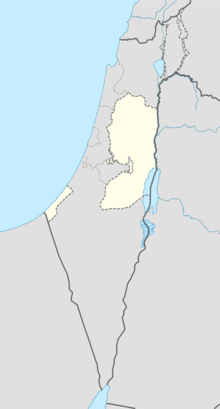Betar (fortress)

Walls from the Betar fortress.
|
|
| Location | West Bank |
|---|---|
| Coordinates | 31°43′48″N 35°08′08″E / 31.73°N 35.135556°E |
Betar fortress (Hebrew: בֵּיתַּר) was an ancient, terraced farming village in the Judean highlands. The Betar fortress was the last standing Jewish fortress in the Bar Kochba revolt of the 2nd century CE, destroyed by the Roman army of Emperor Hadrian in the year 135.
The site of historic Betar (also spelled Beitar or Bethar), next to the modern Palestinian village of Battir, southwest of Jerusalem, is known as Khirbet al-Yahud in Arabic (meaning "ruin of the Jews"). Today, the Israeli settlement and city Beitar Illit is also located nearby.
According to Jewish tradition, the fortress was breached and destroyed on the fast of Tisha B'av, the ninth day of the lunar month Av, a day of mourning for the destruction of the First and the Second Jewish Temple. The city was the stronghold of Bar Kokhba, the leader of the Jewish Revolt under Hadrian. Hadrian sent against the city several of his Roman legions to capture the city. According to historical records, the city was besieged for three and a half years before it finally fell, and its defenders (including children who were found in the city) were put to death. The horrendous scene after the city's capture could be best described as a massacre. A stone inscription bearing Latin characters and discovered near the city shows that the Fifth Macedonian Legion and the Eleventh Claudian Legion took part in the siege. The destruction of Betar in 135 put an end to the last great Jewish revolt against Rome, and effectively quashed any Jewish hopes for self-governance in that period. Accounts of the event in Talmudic and Midrashic writings thus reflect and amplify its importance in the Jewish psyche and oral tradition in the subsequent period. The best known is from the Babylonian Talmud, Gittin 57a-b:
...
Wikipedia

